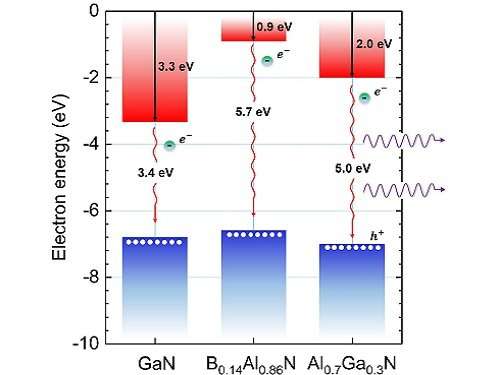Semiconductors with an aligned interface

The electronic characteristics of an interface between two wide bandgap semiconductors are determined by researchers at KAUST: an insight that will help improve the efficiency of light-emitting and high-power electronic devices.
Semiconductors, such as silicon and gallium nitride, have electrical properties somewhere in between those of a conductor and an insulator. They only allow current to flow when electrons have enough energy to overcome a barrier known as bandgap. The bandgap—which may be direct or indirect, narrow or large—determines the properties of semiconductors and their consequent applications.
Materials with a large bandgap, for example, are useful in high-power electronics because they have larger breakdown voltage for energy-efficient transistors as compared with narrow bandgap materials, such as silicon. They can also produce light deep into the ultraviolet part of the spectrum, making them useful for disinfection and water purification.
These materials can be further tailored to a specific application by layering different semiconductors on top of each other to create a so-called heterostructure with the desired properties. But it is vital to understand how the bandgaps of two semiconductors align when semiconductors are brought together in this way.
Haiding Sun and principle investigator Xiaohang Li from KAUST and coworkers from the Georgia Institute of Technology, report that they experimentally measured the alignment of two emerging large bandgap materials: boron aluminum nitride and aluminum gallium nitride.
The 2014 Nobel Prize for physics was awarded in recognition of the development of gallium nitride light-emitting diodes. But, compared to gallium nitride, aluminum nitride has a much larger bandgap of 6.1 electronvolts. Its electronic properties can be tuned by replacing some of the aluminum atoms in the crystal with either boron or gallium.
The team created an interface between boron aluminum nitride with a boron to aluminum atom ratio of 14:86 and aluminum gallium nitride with a gallium nitride ratio of 30:70 on an aluminum-nitride-covered sapphire substrate.
They used high-resolution X-ray photoemission spectroscopy to measure the offset between the top and the bottom of the two material's bandgaps. They show that the bandgaps have a staggered alignment, with both the top and bottom edge of the bandgap of the Al0.7Ga0.3N lower than the respective edge in B0.14Al0.86N.
"Based on the experimental results, we can achieve a much higher amount of two-dimensional electron gas sheet carrier concentration in such junction," says Sun. "The determination of the band alignment of B0.14Al0.86N/Al0.7Ga0.3N heterojunction provides valuable support in the design of optical and electronic devices based on such junctions."
More information: Haiding Sun et al. Band alignment of B0.14Al0.86N/Al0.7Ga0.3N heterojunction, Applied Physics Letters (2017). DOI: 10.1063/1.4999249
Journal information: Applied Physics Letters



















